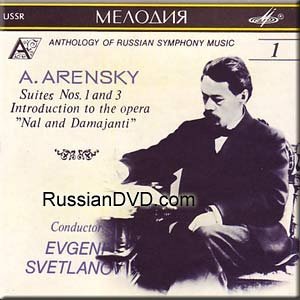Arensky - Suites Nos. 1 and 3, Introduction to the opera "Nal and Damajanti"
Arensky - Suites Nos. 1 and 3, Introduction to the opera "Nal and Damajanti" (1990)

Suite No. 1 in G minor, Op. 7: 1. Variations on a Russian Theme 2. Dance 3. Scherzo 4. Basso ostinato 5. March. play Suite No. 3 (Variations) in C major, Op. 33: 6. Theme 7. Dialogue 8. Waltz 9. Triumphal March 10. Minuet 11. Gavotte play 12. Scherzo 13. Funeral March 14. Nocturne 15. Polonaise. 16. Introduction to the opera/ Nal and Damajanti/. The USSR Symphony Orchestra Evgeni Svetlanov - conductor. Recorded in 1987 (Suites 1, 3), 1990 (opera).
If you love the music of Tchaikovsky and can't get enough of it, this is for you. Arensky was born in 1861 and first studied in Saint Petersburg with Rimsky. After his graduation in 1882 he was appointed professor at the Moscow Conservatory (Scriabin and Rachmaninoff were among his pupils), and fell under the spell of Tchaikovsky, and the influence can be heard in these two Suites. Suite No. 1 dates from 1885 and starts with a set of variations on a popular theme borrowed from a collection of Russian folk songs: there, it is rather Mussorgsky that comes to mind - even the Bach-like fugue that breaks in at 6:50 has something forbidding and grandiose that evokes the religious processions of Mussorgsky. But with the second movement, Dance, the Tchaikovsky influence sets in - here the Tchaikovsky of the ballets, but in the brilliant and propulsive ensuing scherzo (at least in its outer sections) the Symphonies easily come to mind (and a theme strikingly similar to the finale of Bruch's Concerto as well). Arensky doesn't always avoid the pitfall of triumphant bombast, as in the finale of the first suite, titled "March" (and he obviously had a taste for those: there is another one, very similar, in Suite No, 3), but the fourth movement is quite remarkable, also something of a march sounding at times funeral on a Passacaglia-like basso ostinato - Arensky's version of Albinoni's Adagio. And apparently Arensky liked to use these formal elements: there is a fully-fledged and quite effective "Funeral March" in Suite No. 3.
Suite No.3 was first composed for two pianos as a theme and nine variations, and later orchestrated. The same Tchaikovsky reminiscences can be heard, but here decidedly the lighter Tchaikovsky of the ballets. The Minuet, written in 18th Century style with piano and, if ears serve, glockenspiel, is a delicious imitation of a music box (Arensky uses the same kind of effect at 4:55 into the Overture to the opera "al and Damjanti"), and the same 18th Century imitation spills over in the ensuing sturdy Gavotte, with a charming middle section evoking (my interpretation) Queen Marie Antoinette's phantasised shepherds fifing. The piano is featured even more prominently in the penultimate variation, "Nocturne" (the slow movement of a Piano Concerto, really), no doubt to evoke Chopin, but when the strings take over in a great passionate swell, you are in the heart-on-sleeve. ---Discophage, amazon.pl
Judging by the recording data in the heading above this album appears to be a reissue. The four-page sleeve-note has only one page in English with minimal information. I suspect it was first released on the Russian Melodiya label at that time for the Melody logo on this recording appears the same, to my memory.
Arensky’s melodious Suite No. 1 was written in 1885. Svetlanov delivers a performance that beguiles and excites. The opening movement ‘Variations on a Russian Theme’ (a song entitled ‘Having Waved With A Broom’) passes through introspective musings on folk-like material to martial elements à la Tchaikovsky to a stirring fugue. Svetlanov’s ‘Dance’, second movement, charms; it is a waltz - more Russian than Viennese - with a whimsical, rustic central section. The jolly ‘Scherzo’ is all headlong abandon, the woodwinds chuckle away and the strings gambol along merrily before a tender calm slows the merrymakers. The ‘Basso ostinato’ has a warm nostalgic glow while ‘March’ is a glorification delivered one imagines with tongue-in-cheek pomposity, certainly the woodwinds respond cheekily. The whole is quite delightful.
Arensky’s Suite No. 3’s nine variations are based on a meditative consolatory theme. The theme is first discussed between woodwinds and strings before progressing through variations characterised by; a light-hearted waltz - reminding me of the style of the English light music composer Eric Coates, then a sterner triumphal march, softening as it progresses towards old soldiers’ nostalgia (?), a quite enchanting music-box-like 18th century minuet, sparkling with celesta and pizzicato strings, a stately gavotte, a tripping, chattering, busy scherzo, a solemn and most dignified funeral march, a lovely dreamy nocturne with solo piano - somewhere between Chopin and Rachmaninov - and, finally, a colourful and celebratory polonaise.
Arensky’s opera, Nal and Damajanti was written in 1903 and staged at the Bolshoi Theatre one year later. The notes reveal nothing further. I suspect this was an opera that would appeal to families. The music glistens as it opens as though suggesting a world of magic, perhaps a wintry one. Soon a romantic melody surfaces sounding like the Suite No. 3 waltz and, strangely, something Eric Coates might have written. As the pace develops the fantasy continues and the Eric Coates similarities persist for a while - Coates’ Cinderella music, for instance - before the music becomes charged with foreboding, wild and cataclysmic. Arensky’s orchestration is interesting including glittering piano arpeggios.
Enchanting, exciting, tuneful music delivered in style. ---Ian Lace, musicweb-international.com
download: uploaded anonfiles mega mixturecloud yandex mediafire ziddu
Last Updated (Friday, 02 August 2013 09:13)








